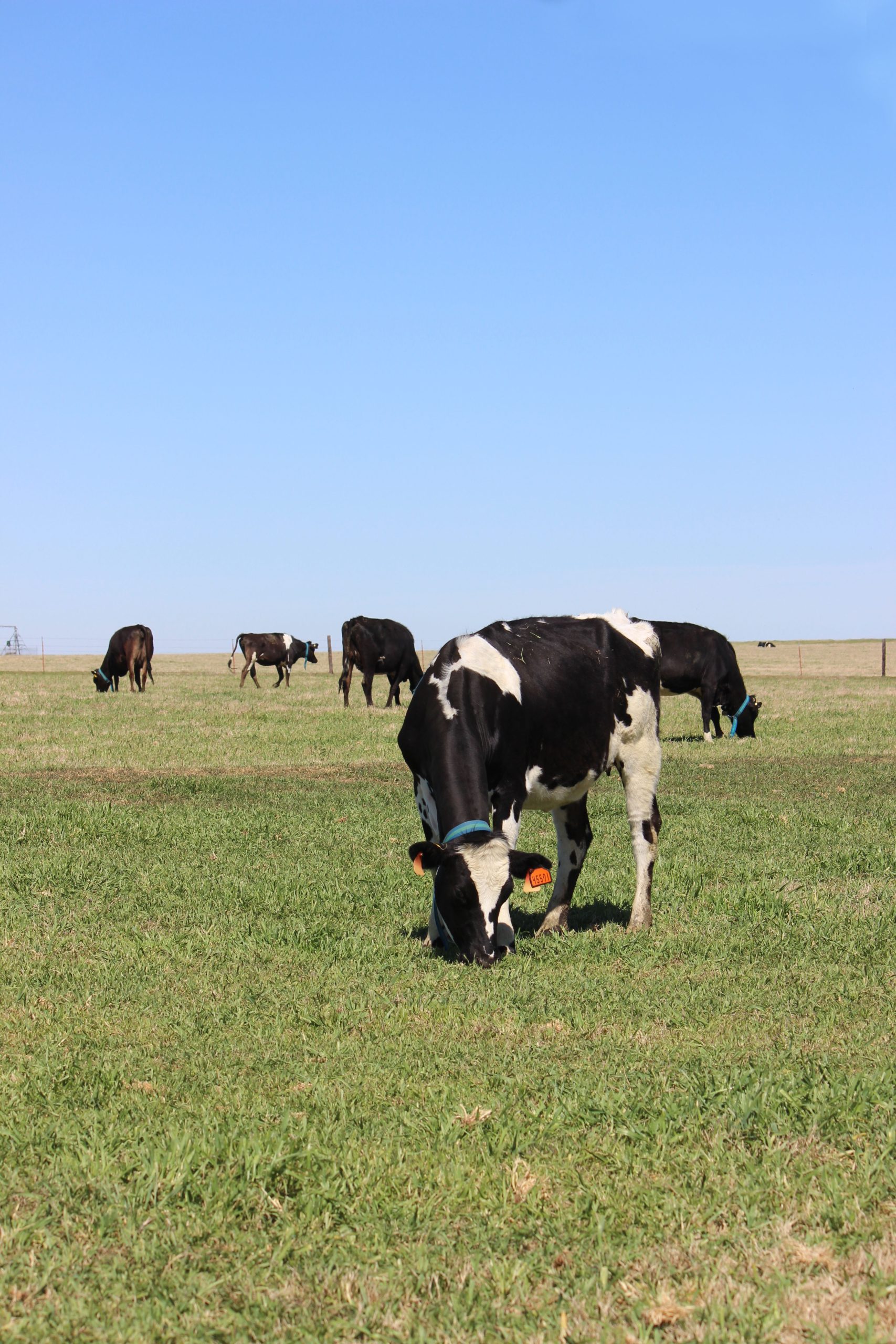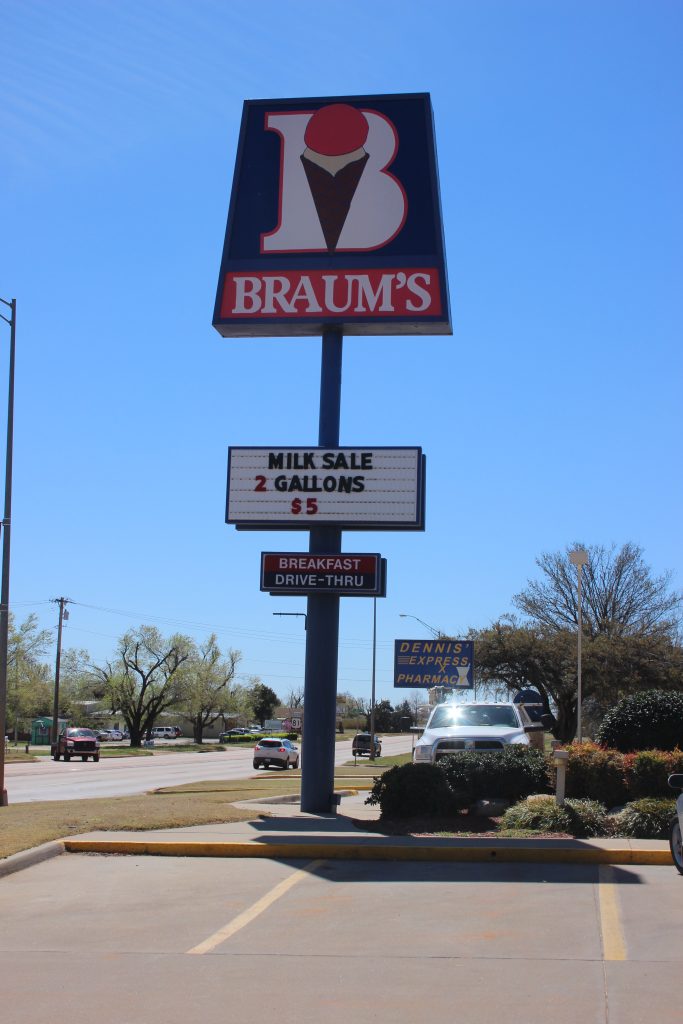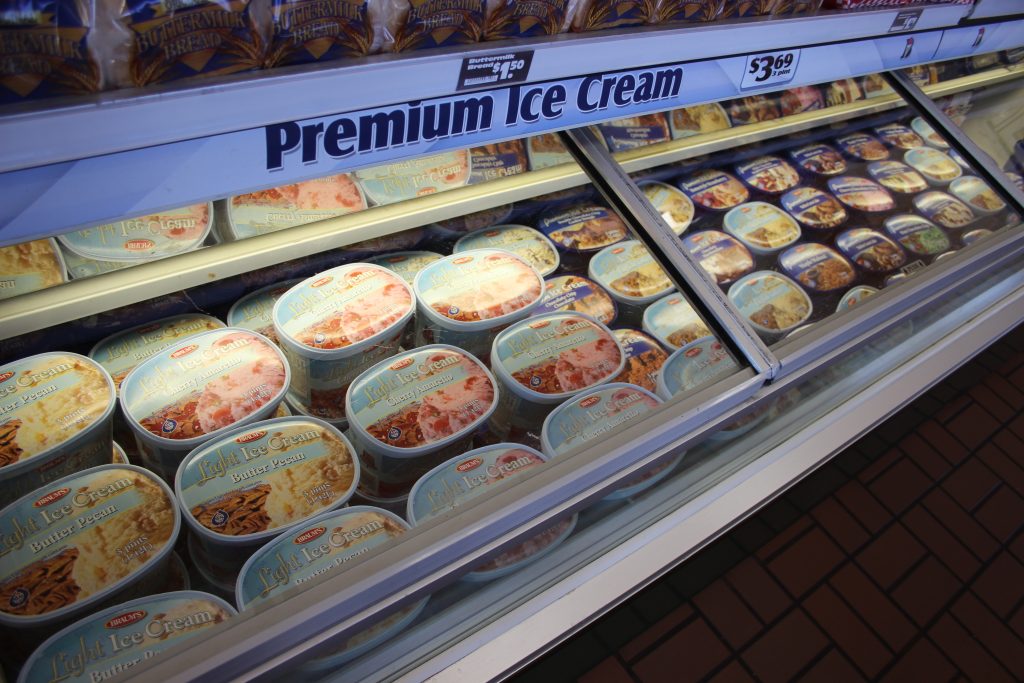The Braum’s Family Farm: 2 scoops of flavor

Editor’s note: This story is reprinted from 2016 in recognition of National Milk Day.
Henry H. Braum began his family’s reign as king of cream modestly. In 1933, he purchased a butter processing plant in Emporia, Kansas, which would later process milk and ice cream as well. By 1945, Henry’s son, Bill, had graduated with a business degree from the University of Kansas and returned home to work with his father.

In 1952, Henry switched gears and began concentrating solely on milk and ice cream while also starting a chain of retail stores in Kansas called Peter Pan Ice Cream Stores. In 1961, Bill purchased the company from his father and his first dairy and herd of cows, but in 1967 he sold the chain of stores to a large retailer; he kept the dairy.
The following year, Bill and his wife, Mary, relocated to Oklahoma to start a new company called Braum’s. In 1968, they proudly opened the first Braum’s Ice Cream and Dairy Store in Oklahoma City, Oklahoma.
By 1971, the Braum family had built a 60,000-square foot processing plant in Oklahoma City, but with their dairy herd still in Kansas, milk had to be trucked to the processing plant daily. In 1975 the herd was permanently moved to their current home in Tuttle, Oklahoma.
In the late 1990s and early 2000s the processing plant, bakery and other aspects of the company slowly made their way to the Braum’s Family Farm in Tuttle, where they are today.
One hundred ice cream flavors later, Bill and Mary still live on the Braum Family Farm, which consists of 10,000 acres and 15 square miles of farm and ranch land as well as the processing plant, bakery and milk barn. Their children, Drew, Elaine, Murray and Rebecca are all part of the Braum’s company in some form. Drew has even followed in his father’s footsteps and is now the president and CEO of Braum’s.
Open doors
Braum’s Ice Cream Stores have been a tradition in the dairy and restaurant industry for years, earning a reputation as a reliable, family business focused on quality and consistency. Braum’s stores are essentially three stores in one. The ice cream of course is a major staple, but Braum’s is also a restaurant serving breakfast, lunch and dinner as well as a mini grocery store carrying over 120 products. Braum’s stores can be found in Oklahoma, Kansas, Texas, Missouri and Arkansas, with 280 locations in operation.

“As a family-owned producer in the Midwest and southern region, Braum’s prides itself in offering quality products to its customers,” said Amanda Beuchaw, Braum’s public relations director.
In recent years, people have become more and more concerned with how and where their food is produced. To let consumers experience Braum’s practices and methods, free tours are offered at the processing plant and bakery. Patrons are even served a complimentary Braum’s ice cream bar at the completion of the tour.
“We wanted to allow people to see where their products were coming from, and after the entire operation was moved to Tuttle, the public expressed an interest in the farm, which lead to the family opening it up for tours in 1990,” she said.
Braum’s Farms are vertically integrated, meaning they build their products from the ground up and visitors are able to grasp this concept in its entirety on the tour. This practice keeps costs down and provides quality control over what is and isn’t in their final product.
“We own our own dairy herd, processing plant, farms and ranches, delivery trucks, bakery, retail stores, construction company, advertising agency, print shop and cabinet shop,” she said. “We even make all the packaging for our products, so it’s really a full circle operation.”
What goes in
Braum’s famous milk and ice cream starts with what goes into their cows, as opposed to what comes from them.
To make certain the herd is fed only the highest quality rations, nearly all their feed is grown and harvested by Braum’s. There are a total of eight Braum farms and ranches across Oklahoma and Texas, totaling 48,000 acres and 62 square miles.
The two main crops they grow are corn and alfalfa. Center pivot irrigation is used to ensure high yields and quality feed for the dairy herd. Cover crops are utilized once the crops are harvested to protect the soil until they are plowed under in the spring.
The alfalfa cuttings and a portion of the corn are harvested as ensilage. Braum’s farms have the ability to store 240,000 tons of silage per year. The residual corn crop is garnered as shelled corn and is used as a main component in the diet of the dairy herd.
Although the Braum’s Dairy is almost completely self-sufficient, some additives are purchased from outside the farm. Grain—which includes milo, barley, soybeans and corn grown locally—is obtained to supplement the rations.
The grain is mixed with the corn and alfalfa silage to improve efficiency. The rations are mixed at a feed mill on the Tuttle farm, which is also where the soybeans are roasted to make they more readily digestible. Since the feed mill is onsite and operated by Braum’s employees, they are able to certify the source and national value of the ingredients.
“We want people to know that they are buying a product that we whole-heartedly believe in,” Beuchaw said. “There’s a lot of work that goes into a dip of Braum’s Ice Cream or a glass of Braum’s milk.”
Braum’s actually operates two dairies; the headquarters in Tuttle and another smaller farm in Follett, Texas, consisting of 24,000 acres. An estimated 40 calves are born in a day on the Tuttle and Follett farms.
Once a cow has calved they join the milking herd where they will produce milk for about 300 days. Around this time the cow will stop producing milk and will be transferred to Bermuda pasture in Ada, Oklahoma, to a take a vacation from the hard work of being a dairy cow. Once the next calving year begins the cycle will start all over again.
An estimated 10,000 dairy cows call the Braum Family Farm their home and it is one of the largest dairy operations in the world and the only known major ice cream maker to milk their own cows. In contrast to some dairy companies, Braum’s does not try to increase milk production through hormones and medicated rations.
“Braum’s milk is fresh, natural and rBGH free,” Beuchaw said. “We don’t inject our cows with hormones to stimulate milk production and we don’t add antibiotics to their feed.”
Braum’s cares about their cows—that’s a given. The Family Farm boasts 17 free stall barns, each one the size of two footfall fields, expanding over 35 acres of land. After milking, the cows have a choice between heading to the pasture or riding a specially designed cow trolley back to the free stall barns, to reduce the amount of walking. The cow trolley is basically a motorized walkway; only it can hold several more tons then the ones seen in airports.
All those cows produce tons of milk, but there is another thing they tend to yield a great deal. The floors of the free stall barns are flushed and cleaned between every milking. The manure and other waste are flushed to a concrete ditch where the fibrous material, such as straw and composition bedding, are separated from the liquid waste.
The liquid waste is run through the irrigation systems and used to fertilize the cropland. The fibrous materials are also spread on the crops as a compost fertilizer. Utilizing the manure from the cows greatly reduces the need for chemical fertilizer and provides a much-needed use for waste from the dairy herd.
Additionally, the Tuttle farm utilizes a wastewater treatment plant to recycle discarded water, keeping excessive water usage in check.
Dairy workers keep milking cows constantly, only stopping to clean housing areas and equipment. In fact, 800 cows are milked in an allotment of 32 minutes. Incredibly, 30,000 pounds of milk is produced in one hour. Each cow is milked twice a day and gives roughly 100 glasses of milk.
When combined, the Braum dairy herd fills over 1 million glasses daily. Milk from both the Follet and Tuttle farms is transported to the processing plant daily. Since freshness is key element of the Braum’s equation, all milk is delivered to retail stores in 36 hours or less from leaving the cow.
Utterly efficient
The 260,000-square foot processing plant is a beast in and of itself. Visitors on the tour are able to see the assembly of their favorite Braum’s treats such as frozen snacks, cottage cheese and of course, ice cream.
“We pour our heart and soul into every gallon, dip, cookie and cone,” Beuchaw said.
Milk is packaged at a rate of 6,000-gallon jugs an hour and all this can be viewed from an overhead balcony by those touring the Willy Wonka-esque facilities. Raw milk is cooled, pasteurized, standardized, homogenized, vacuum processed and finally cooled again and packaged.
To prevent dangerous contamination, all water pipes are either placed under floor or along walls of the factory, never above the machines, which helps to prevent contagions from reaching food.
A company on the cutting edge of milk production, Braum’s uses one piece of equipment other dairy processors do not. The mechanical vapor recompressor, or MVR, removes 40,000 pounds of the milk’s natural water per hour, adding up to 50 percent more calcium and protein to each jug of low fat or skim milk. This makes a thicker, more nutritional and better tasting product. In fact, it takes three half gallons of regular milk to make two half gallons of Braum’s milk.
Another major component of the Braum’s tour is the bakery. The tour allows visitors to watch their favorite Braum’s foods baked and packaged. Breads, including hamburger buns and ice cream cones used in Braum’s stores, as well as cookies, rolls and muffins are all made fresh daily at the bakery in Tuttle.
Trucks deliver fresh product shipments to retail stores seven days a week and since they are a family company, all stores are located within a 300 miles radius of the processing plant, guaranteeing all drivers can be home with their families every night.
The transparency of the Braum’s Family Farm is a testament to the pride and confidence they have in their products. These days most agriculture companies have to use secrecy as a means of protection. Braum’s willingness to open their doors is exactly what builds trust in their brand and in turn builds trust in agriculture’s brand.
“People like to know what they are buying and we allow them access to Braum’s in that sense,” Breuchaw explained. “In the end it comes down to quality and consistency in offering a good product. Both of these objectives are our top priority.”
Braum’s is not currently offering tours at this time due to remodeling. They will reopen at a later date.



